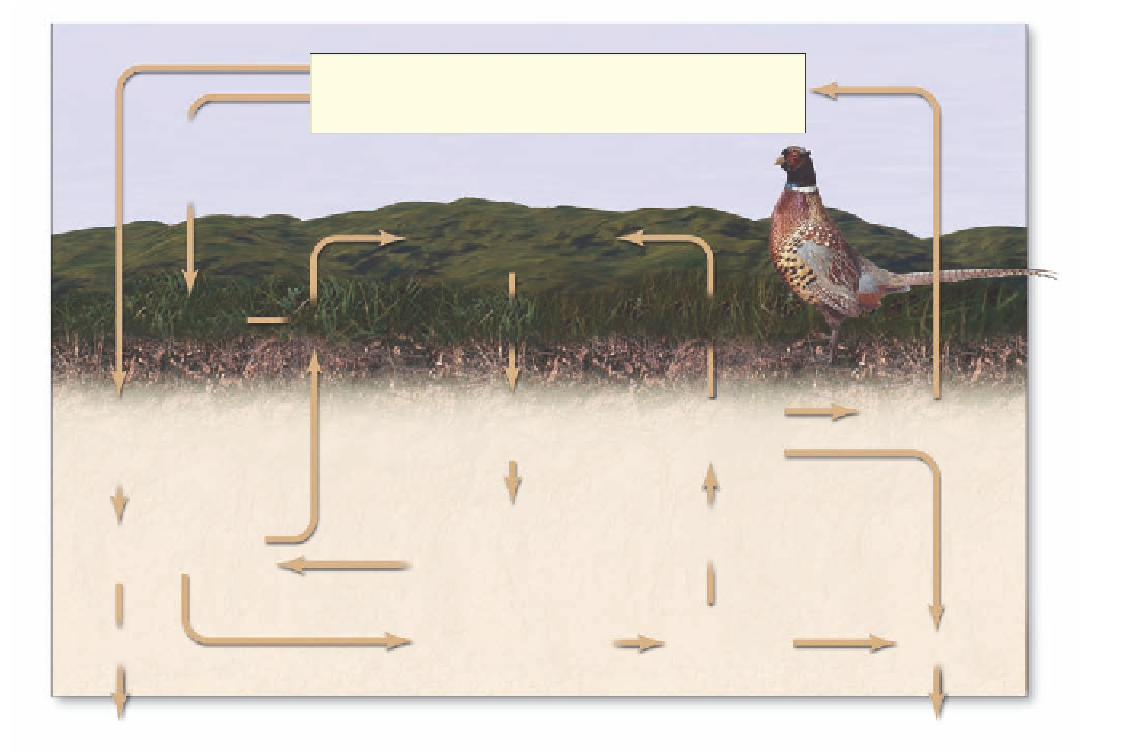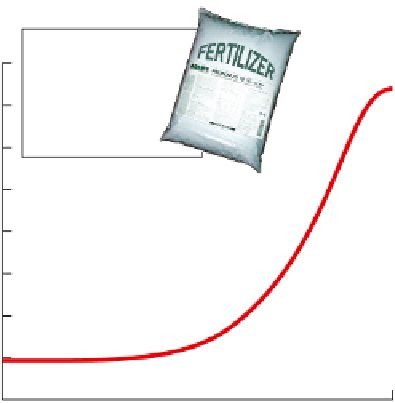Environmental Engineering Reference
In-Depth Information
Gaseous Nitrogen (N
2
)
in Atmosphere
Nitrogen
Fixation
by industry
for agriculture
Food Webs
on Land
uptake by
autotrophs
excretion, death,
decomposition
uptake by
autotrophs
Fertilizers
Nitrogen Fixation
bacteria convert N
2
to
ammonia (NH
3
); this
dissolves to form
ammonium (NH
4
+
)
NO
3
-
in Soil
Denitrification
by bacteria
Nitrogenous Wastes,
Remains in Soil
2. Nitrification
bacteria convert NO
2
-
to nitrate (NO
3
-
)
Ammonification
bacteria, fungi convert the
residues to NH
3
; this
dissolves to form NH
4
+
NH
3
, NH
4
+
in Soil
1. Nitrification
bacteria convert NH
4
+
to nitrite (NO
2
-
)
NO
2
-
in Soil
loss by
leaching
loss by
leaching
Active Figure 3-27
Natural capital:
simplified model of the
nitrogen cycle
in a terrestrial ecosystem. Nitrogen
reservoirs are shown as boxes; processes changing one form of nitrogen to another are shown in boxed print.
See an animation based on this figure and take a short quiz on the concept.
(Adapted from Cecie Starr and
Ralph Taggart,
Biology: The Unity and Diversity of Life,
9th ed., Belmont, Calif.: Wadsworth, © 2001)
Phosphate can be lost from the cycle for long peri-
ods when it washes from the land into streams and
rivers and is carried to the ocean. There it can be de-
posited as sediment and remain trapped for millions of
years. Someday the geological processes of uplift may
expose these seafloor deposits, from which phosphate
can be eroded to start the cyclical process again.
Because most soils contain little phosphate, it is of-
ten the
limiting factor
for plant growth on land unless
phosphorus (as phosphate salts mined from the earth)
is applied to the soil as a fertilizer. Phosphorus also
limits the growth of producer populations in many
freshwater streams and lakes because phosphate salts
are only slightly soluble in water.
200
150
Nitrogen fixation by natural processes
100
50
N
gen fixati
Effects of Human Activities
on the Phosphorus Cycle
We remove large amounts of phosphate from the
earth to make fertilizer, reduce phosphorus in tropical
soils by clearing forests, and add excess phosphates to
aquatic systems.
We intervene in the earth's phosphorus cycle in three
ways.
First,
we mine large quantities of phosphate
0
1920
1940
1960
1980
2000
Year
Figure 3-28
Natural capital degradation:
human interference
in the global nitrogen cycle. Human activities such as produc-
tion of fertilizers now fix more nitrogen than all natural sources
combined. (UN Environment Programme, UN Food and
Agriculture Organization, and U.S. Department of Agriculture)













